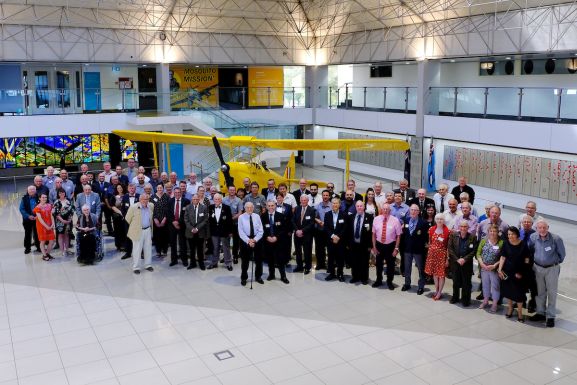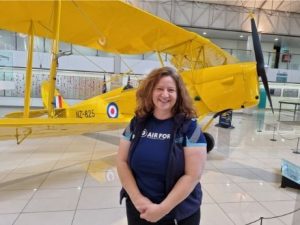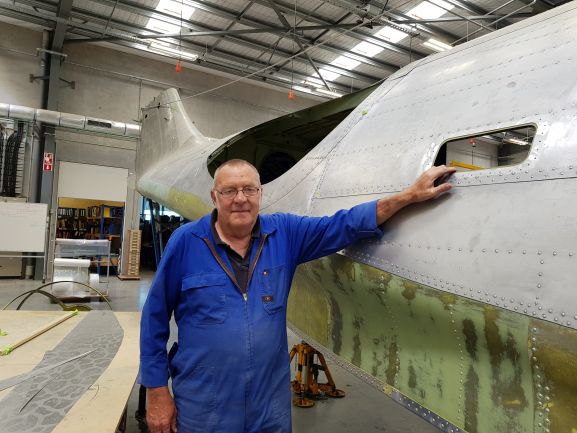
Smokey Dawson
Technical Volunteer
You will most commonly find Smokey these days in the Museum’s workshops, beavering away on the Catalina. Although he’s only been volunteering with us since 2013, his association with the Museum, and with the Catalina in particular, goes back much further.

Ray Sheridan
Volunteer Guide
Ray Sheridan began volunteering with us as a guide in 2015, motivated in part by an interest in aircraft, but also a family association – he has a granddaughter who is a medic in the Air Force, currently based at Woodbourne.
Smokey Dawson – Technical Volunteer

Smokey’s first contact with the Air Force Museum began when he was still in the Air Force in the mid-1980s. He worked on the original restoration-rebuild of the Catalina at Whenuapai in 1984-1988 and was also part of the team that brought the Dauntless wreck back from the Pacific in 1988. Further to this, he would frequently collect collections donations on behalf of the Museum from around the Auckland area.
A former competitive darts player and rugby coach, Smokey tends to spend his down time these days visiting his daughter on her farm at Amberley, doing Sudoku puzzles and watching a bit of TV. His favourite film, for the record, is the ‘Sound of Music’!
Smokey says that a desire to reconnect with the Museum and keep busy was behind his decision to volunteer with the technical team. When asked what he enjoyed most about volunteering here, he replied without hesitation – “the people. It’s a good group of people.”
Ray Sheridan – Volunteer Guide

Ray is no stranger to military ways himself, having done three years’ National Service with the Army in the early 1960s. He served with the Artillery, and spent some time in Waiouru before being posted down to Canterbury with 32 Battery, 3rd Field Regiment.
Most of his working life, however, has been spent in accounting and business administration, with the last 25 being in the IT sector. Having been born and raised on farms in Canterbury, Ray never strayed far from rural life, employing his skills in the dairy and meat producing industries, and later, with an agricultural wire manufacturing company.
Since his retirement, he has enjoyed finding new ways to keep busy and maintain social interaction with people. As well as volunteering with us, he also donates his time (together with his wife) to Age Concern. He drives a van for them, picking up older people and taking them to a host for morning tea, then bringing them back home – valuable interaction for people who otherwise may be quite isolated. When he’s not busy volunteering, Ray enjoys gardening, walking, and family time. He doesn’t claim to be a big “movie person”, but is partial to Mark Knopfler’s music.
You’ll find Ray on duty here at the Museum both on Thursdays and Sundays. He loves the social interaction and mental stimulation, and feels that the fact that you’re “always learning” and “get to meet people from all over the world” are the biggest highlights of being a guide. When asked if he had a favourite thing in the Museum, he replied, “the Memorial Alcove… it’s a beautiful piece of art.”
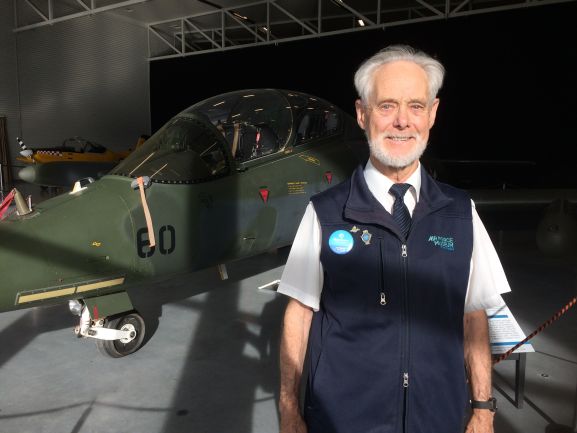
Rhys Evans
Volunteer Guide
While visiting Wigram airfield to board a commemorative DC-3 flight in 2006, Rhys was encouraged by a colleague, firstly, to visit the Air Force Museum and, secondly, to become a volunteer guide here. Some 13 years later, Rhys has established himself as a valuable member of the Thursday guiding team, sharing his passion and knowledge with visitors from far and wide.
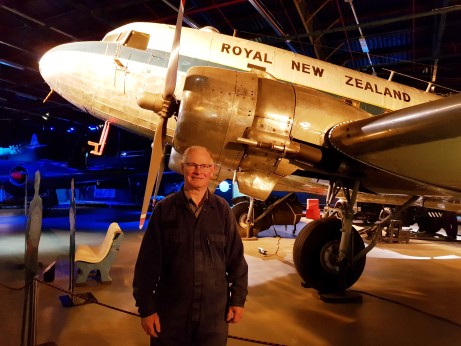
Ron Reeve
Technical Volunteer
After a lifetime spent ‘playing with aeroplanes’, volunteering in the technical section here at the Air Force Museum seemed a natural way for Ron Reeve to spend his retirement.
Rhys Evans – Volunteer Guide
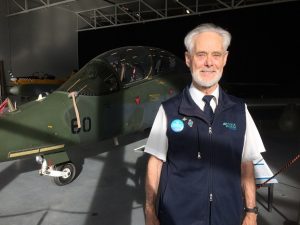
Born in Salford, England, Rhys left school at the age of 15 and joined the Royal Air Force (RAF) as a Boy Entrant. He was educated and trained by the RAF as an aircraft technician and ended up on-squadron under-aged, which meant that when his first squadron posting came up, he couldn’t go!
In his 13 years of service with the RAF, Rhys initially worked on Canberra aircraft, with other highlights that included being involved in the introduction of the Vulcan bomber, a posting to Goose Bay (Labrador, Canada) and time spent working at the Flying Training School.
In 1966, motivated by New Zealand aviation’s amazing safety record and its need for people in the trade, Rhys moved to New Zealand and was hired to work with National Airways Corporation (NAC) in a range of technical roles. His intention was to “give it a year or two” and then return to the UK. Some 39 years and 9 months later, after working for both NAC and its successor, Air New Zealand, Rhys took voluntary redundancy and settled in to a busy retirement, still in New Zealand!
These days, apart from volunteering his time to the Museum, Rhys is very much involved with church work, a feature and love of his life for the last 50 years, and he enjoys travelling around the world catching up with family and friends. A keen cyclist, Rhys is seldom spotted driving a car, and he attributes cycling to keeping him fit over the years and helping with his bad back!
When asked what he enjoys most about volunteering at the Museum, Rhys says, “The people you meet, and the people you work with.” His favourite object is the Canberra, one of at least 30 different aircraft types that he has worked on over the years.
Rhys doesn’t have a favourite movie but, apart from appreciating some children’s films, he enjoys watching Agatha Christie’s Poirot with friends and family.
Ron Reeve – Technical Volunteer
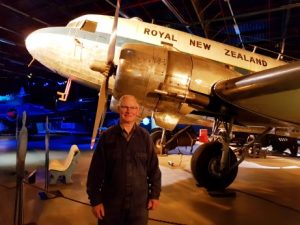
Ron started out with NAC as an aircraft maintenance engineering apprentice in 1965. By an incredible coincidence, the first aircraft he worked on was Dakota NZ3551, now in the Aircraft Hall (NAC did some aircraft servicing back then for the RNZAF). It’s perhaps no surprise, then, that this is his favourite thing in the Museum – ‘I just love that aeroplane’, he says.
Ron’s time with NAC and Air New Zealand took him from heavy maintenance as an aircraft mechanic, to stints as an inspector on propeller overhauls, maintenance forward planning, technical services, publications, structural repair, aircraft systems, and engine and component management. He managed the engine fleet for Air New Zealand national and Mt Cook Airline, with a budget of around $10 million annually, and was the project leader for the exit of the Boeing 737-200 fleet.
Ron left Air New Zealand in 2002, 37 years to the day after he joined. A period as a technical rep for three different aircraft leasing companies followed, and he spent eight years travelling all over the world looking after the redelivery of aircraft from sale to end of lease, and some repossessions. After getting tired of ‘living out of a suitcase’, Ron got a contract with a company in Denver, Colorado, reporting on aircraft engine conditions and histories, before finally retiring five years ago.
All up, Ron has spent 50 years ‘playing with aeroplanes’; he calls it ‘playing’, he says, because he enjoys it so much. His passion for aviation is what led him to start volunteering here nearly three years ago, prompted by conversations with Trust Board member and long-time associate, John Mounce. The things he loves most about working in the tech section is ‘being around old aeroplanes and a great bunch of people.’ He has also really enjoyed getting to work with the Gateway aviation students, and mentoring a new generation of potential aircraft engineers.
When he’s not at the Museum playing with aeroplanes, Ron may be found pursuing his other love – old Jaguar cars. He is President of the Christchurch Jaguar Drivers’ Club, and is currently restoring a 1955 Jaguar XK140. And apparently he doesn’t really have a favourite film, but does enjoy watching Antiques Roadshow!
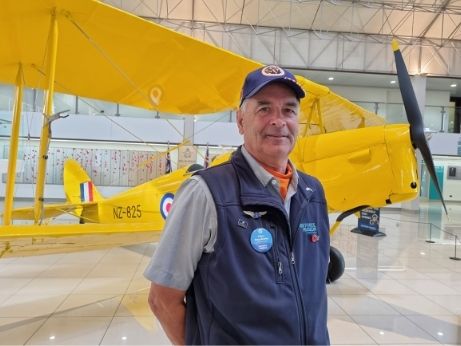
Hans Nagelkerke
Volunteer Guide
Hans Nagelkerke hails from the Netherlands, where he did a period of service in the Dutch Air Force, beginning as an assistant engineer and finishing up as a crew chief on the Lockheed F-104 Starfighter. When he left the military, the job market in the Netherlands was not all that positive, so following recommendations from family already in New Zealand, he emigrated in 1981.
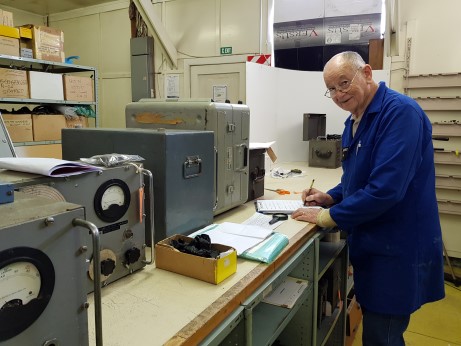
Mike Harrison
Technical Volunteer
For ex-RNZAF Mechanical Transport (MT) driver, Mike Harrison, volunteering in the technical section at the Air Force Museum was top of the list when he retired – he was so keen, in fact, to be back amongst old mates, that he started here on his very first day of retirement, back in 2005.
Hans Nagelkerke – Volunteer Guide
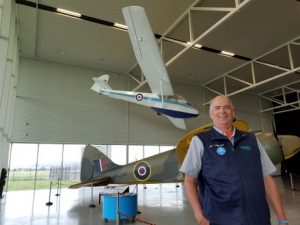
Back then, jobs in the aeronautical industry were hard to come by in New Zealand, so he moved instead into nautical engineering, and worked for 2.5 years as a marine engineer in Lyttelton. After a stint as the chief engineer for a printing company, Hans finally got back into aviation, when he landed a job as an engineer with Air New Zealand in 1989. There he stayed for the next 26 years, although only the first six were spent as a ‘hands-on’ engineer, the rest was in planning, etc. He was a member of the team that worked on the exit of the Boeing 737 fleet, which was led by fellow Museum volunteer Ron Reeve.
Hans’ involvement in aviation was not limited to the workplace. During the 1980s he helped build a single-seater aircraft which he later flew, having obtained his pilot’s licence in 1991. He used to take part in flying days here at Wigram, with former Air Force Museum Director, Dave Provan. In another connection with Wigram, Hans was also an active member of the Pegasus Land Yacht Club, which used the airfield once a month in the early 1980s, and held 24-hour races here for the Telethon fundraisers in 1982-83.
Having retired nearly three years ago, Hans began volunteering here at the Museum in April this year, encouraged by his uncle and former guide, Peter Wynands. When Peter decided it was time to retire from guiding, it seemed an ideal solution for Hans to take his place. When asked what he enjoys most about being a guide, Hans answered without hesitation, ‘The interaction with people.’ He enjoys being able to bring a different perspective, particularly being able to speak to Dutch and German visitors. His favourite thing in the Museum is the Schleicher Ka-4 glider, as he did his first solo flight in the Ka-7 model, before going on to do over 400 hours in gliders.
When he’s not working as a guide here at the Museum, Hans also volunteers as an ambassador at Christchurch International Airport, manning the help desks, and, like Thursday guide Ray Sheridan is a driver for Age Concern. When he’s not busy volunteering, Hans enjoys flying the impressive flight simulator which he built himself at home, complete with screens, switches and controls. He also enjoys flying radio control aircraft, and is a lifetime member of the Air New Zealand Flying Club and current Treasurer of the Air New Zealand Retirees Club.
Mike Harrison – Technical Volunteer
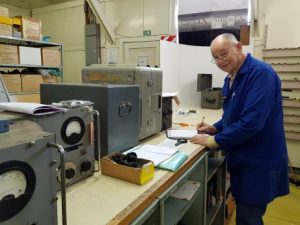
Mike joined the Air Force in June 1958 and did his recruit training at Taieri near Dunedin, not long before it closed as an RNZAF station. He did his basic driver’s course at Hobsonville, before being posted to Ohakea, and later, a requested exchange posting to Wigram, so he could be closer to his soon-to-be wife, whom he’d met on a blind date in Palmerston North. Wendy was from Dunedin, so Mike did a fair bit of commuting between Christchurch and Dunedin before they were married in 1963.
During his more than 20 years in the Air Force, Mike recalls a number of standout memories, including a year-long stint at the Chief of Air Staff’s (then Air Vice-Marshal Douglas St George) personal driver, as well as being part of the RNZAF team that helped out following the Inangahua earthquake in 1968. His ultimate career highlight was a two-year posting to Tengah, Singapore, where he ran the transport section on No. 41 Squadron. He vividly recalls the time that the Prime Minister, Robert Muldoon, paid a visit and was introduced to the unit’s canine mascot, who was named after him. Mike remembers the PM not being overly impressed – “he just grunted and walked away”!
After a terminal posting to Wigram, Mike retired from the Air Force in 1981 and went on to a succession of different jobs, the first of which was as a driving instructor for the Automobile Association, which he enjoyed immensely. He trained 1,000 students in the four years he spent in that role. Eventually, he ended up as a technical assistant in the Planning and Policy department of the Christchurch City Council, and it was from there that he retired on 7 June 2005.
After 13 years as a volunteer, Mike still loves it here, and says it’s the camaraderie that he enjoys most – “It’s like being back in the Air Force, but without the uniform”. Most of his volunteer hours these days are spent helping out the Collections team; he is currently carrying out an inventory of the communications equipment in No. 3 Store with fellow RNZAF veteran, Bob McLellan. While he doesn’t come from a technical trade, Mike has an incredible talent for model engineering, with skills he has picked up over the years from watching others at work and giving things a go himself. He credits the Air Force with instilling in him “the greatest sense of learning” – always fascinated by how things work, he says he was lucky in his trade to have been exposed to a wide range of different people and skills, so he was able to pick up different bits and pieces wherever he went.
Mike is a member of the Canterbury Model Engineers’ Club, and has a train (emblazoned with Air Force Museum branding!), which he runs at the Halswell domain. He is also currently building a 5ft radio-controlled scale model of the British warship HMS Brave Swordsman, and has spent two years crafting two intricately detailed 40mm Mk.9 naval Bofors guns to mount on the model. When he’s not at the Museum or in his own workshop, Mike is also the Secretary of the Canterbury branch of the RNZAF Association.

Emma Johnson
Registrar
When Emma Meyer (now Johnson) first started at the Museum as a collections technician back in February 2009, it was only meant to be for a few months’ maternity cover. Ten years and several different contracts later, however, Emma is one of our longest-serving Collections staff members, and an integral part of our team. As our Registrar, she is the first port of call for anyone looking to donate material to our collection.
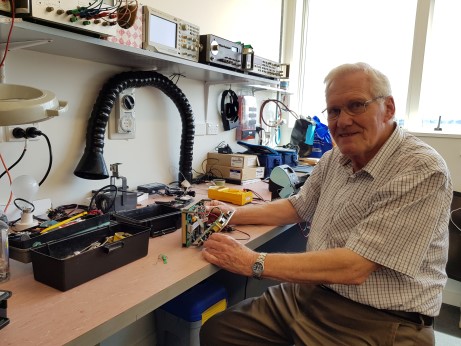
Cliff Waites
Audiovisual Volunteer
When Cliff Waites signed up as a volunteer back in 2005, he offered his services in not one, but two areas – both as a guide, and also as a volunteer assistant for our Audiovisual (AV) Technician, David Nicholson. With his background as an instrument assistant/avionics technician, Cliff is certainly well qualified for the latter!
Emma Johnson – Registrar
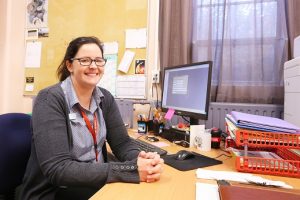
Emma was born in Christchurch and grew up on a sheep farm in North Loburn. Her path to becoming a museum professional began when she completed a Bachelor of Arts, majoring in History, at Canterbury University. This led her on to Wellington, where she did a Master of Museum Studies at Victoria University and also her first paid museum job – a part-time archives assistant role at Te Papa. Then followed a series of practical placements at the Ministry for Culture and Heritage, Heritage New Zealand, Canterbury Museum and Christchurch Art Gallery, before she came here to the Air Force Museum.
When her maternity cover role ended, Emma was engaged in another fixed-term contract, working on the first phase of our clothing store project, before taking up a temporary Assistant Registrar role at Southland Museum in Invercargill. When that contract ended just as the permanent Collections Technician role here became vacant, she jumped at the opportunity. The rest, as they say, is history, although she did have one more change when she took on the re-established role of Registrar in 2015.
Emma’s role is largely ‘back of house’, and you may be forgiven for wondering what it is a museum Registrar does. She has given the following explanation: “As the name suggests, I spend a lot of time registering (or accessioning) new donations and making sure the documentation around our collection objects and loans is complete. I am the point of contact for donors, oversee the Acquisitions and Disposals Committee process (for objects that don’t require Trust Board approval), make sure all our forms and loan documents have all the legal and ethical aspects covered, and administer our collection database [known as] Vernon. Basically, I look after the process of objects coming in, out, and around the Museum, making sure we know where everything is and/or where it’s going.”
Despite not coming from a military background, Emma has formed a real affinity with our collection, and she cites this as one of the things she enjoys most about working here. “I find this collection really interesting, especially the social history aspects around those who served in the Air Force. More specifically though, I get great satisfaction in making sure we know as much possible about an object from a documentation point of view – my approach is to think about the AFM museum professionals of the future, and make sure they will have a real understanding of where an object came from, why we collected it and its significance.” Emma finds it difficult to cite one object as a favourite, preferring to discuss how the privilege of working so closely with the collection enables her to get “a sense of the person who owned them and their experiences.”
In her spare time, Emma enjoys spending time with family and friends, reading, watching Netflix, going for walks, and most recently, yoga. She also loves going to the movies, and her current favourite is Queen biopic, ‘Bohemian Rhapsody’.
Cliff Waites – Audiovisual Volunteer
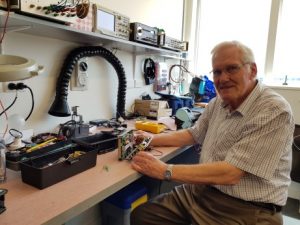
Cliff joined the RNZAF as a boy entrant in 1954, and went on to do his trade training at Hobsonville, qualifying as an instrument assistant, before also doing a Fitters and Mechanics course at Wigram. He spent much of the next eight years in uniform at No. 1 Repair Depot at Woodbourne, working on the rebuilds of the Harvards. He also had an exchange posting to Wigram, where, along with Devons and Harvards, he had the opportunity to work on the RNZAF Antarctic Flight aircraft and some of the US Antarctic Dakotas.
Following his retirement from the Air Force, Cliff went on to NAC, where he continued his specialisation in aircraft instruments, becoming an avionics technician. He spent 42 years with NAC/Air New Zealand, based in Christchurch, working on DC-3s, Friendships, Viscounts, and Boeing 737s, as well as time ‘in the workshops’ on electrical instruments such as auto pilot and flight director systems. He was also an on-call engineer, which regularly involved flying up to Auckland for overnight work, then back the next day.
While he’s no longer serving as a guide, Cliff comes in once a week on Wednesdays to help David with any ‘odd jobs’ as required, including repairing test equipment and making up cables. He can often be found at work on a piece of equipment in David’s office, or accompanying him on tasks around the Museum. Once again, he says it’s ‘the people’ that is the most enjoyable thing about working here, and says everyone he meets is ‘friendly enough’. Given his former life, it’s perhaps not surprising that his favourite aircraft in the Museum are the Harvard and Dakota. Cliff’s a keen gardener in his spare time, and while he doesn’t have a favourite film, he is an ‘old time’ big band fan.
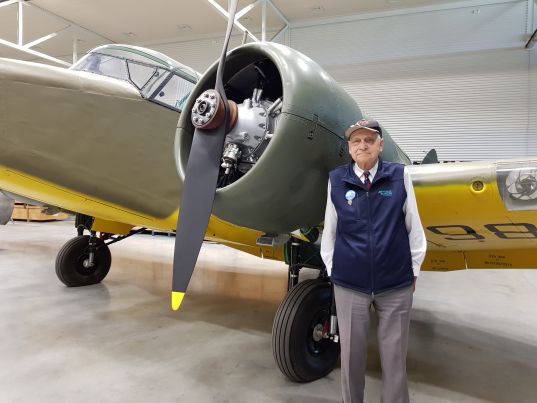
Alan Dower
Volunteer Guide
Retired plumber Alan Dower has certainly had an eventful life. From being evacuated from London as a child during World War Two, a stint of National Service in the RAF, and 15 years working in Hong Kong, where he also served with the Auxiliary Police Helicopter Observer Squadron, he now spends his Wednesdays volunteering as a guide here at the Museum.
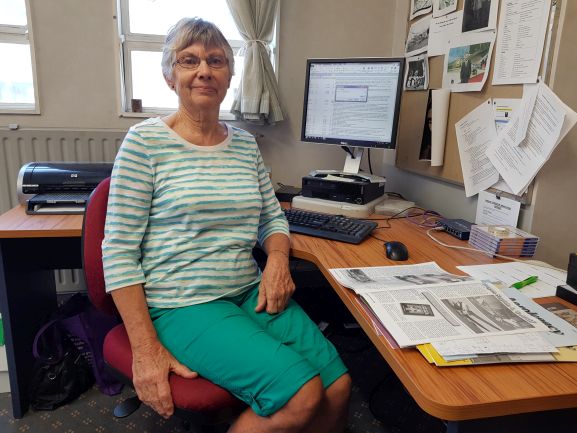
Evelyn Robertson
Archives Volunteer
It was an encounter at a meeting of her local branch of the New Zealand Society of Genealogists over ten years ago which led retired librarian Evelyn Robertson to begin volunteering in the archives here at the Air Force Museum.
Alan Dower – Volunteer Guide
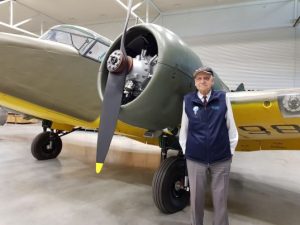
After the War, he joined the Air Training Corps (City of London Squadron), and it was while serving with the ATC that he had his first flight, in an Airspeed Oxford, from RAF North Weald. Another particularly memorable flight was when, in 1946, he went on a nearly six hour round trip from RAF Loughborough to Ireland in a Dakota, just to pick up some crates of Guinness for the Officers’ Mess!
Alan took up plumbing as a trade, and worked at London airport and Windsor Castle. This was punctuated by two years’ National Service in 1951-53, which he did with the RAF, serving as a jet engine mechanic on Canberra bombers. During his time with the RAF, he got to fly in two Canberras, and once in a two-seater Meteor. In a strange twist of fate, Alan was actually down to be in the ground crew in support of the RAF Canberra entries in the 1953 London to Christchurch Air Race, but unfortunately, he was due to be ‘demobbed’, just a couple of months prior to the Race.
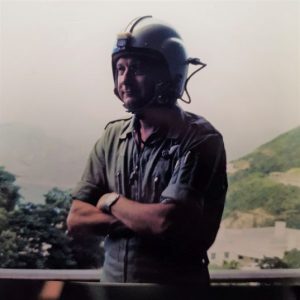
After 15 years and two children later, Alan and his wife decided that it was time to move on, so they made the decision to come to New Zealand, arriving here in 1971. Alan got a job with the Auckland Education Board, and spent the next 18 years looking after heating plants and swimming pool filtration systems in over 300 schools, before taking an early retirement and shifting down to Christchurch, following his younger son who had transferred here for work.
Alan began volunteering at the Air Force Museum in 2006, prompted by his son, who thought it would be ‘something for him to do’, and he’s been a stalwart of the Wednesday guide team ever since. He loves meeting people from all over the world, and says he wears his distinctive ‘Memphis Belle’ baseball cap as a conversation starter for American tourists. He explained the special significance of this, as during his time with the RAF he was stationed at Basingbourne, the same station that the famous American bomber flew from during the War, and he took off three times from the same runway.
In his spare time, Alan has been a keen archer since his days in Hong Kong, and still likes to get out around the archery course today, although he concedes that he’s starting to find it a bit more challenging than he used to. He’s a life member of both the Canterbury Archers Society and the Pine Ridge Archery Club in Auckland. He was also a keen sailor, and had his own boat in Hong Kong.
While he doesn’t really have a favourite film, Alan does admit that Gone with the Wind is a good one. Otherwise, he enjoys reading Aeroplane magazine, or catching up on the latest Air Force News.
Evelyn Robertson – Archives Volunteer
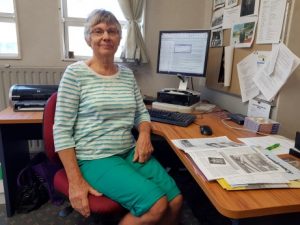
Our former Research Curator Vicky Garrington was giving the group a talk about the Air Force Museum archives, and Evelyn approached her afterwards to ask if she needed any volunteers. Upon hearing about her librarian background, Vicky snapped her up, and Evelyn began volunteering with the Research Team in 1 Store at the beginning of 2009.
From Ashburton originally, Evelyn did her library training in Wellington. Her first librarian job was at Otago University in Dunedin, before she moved overseas with her husband Alistair, an electrical engineer. After four years in the UK they moved to Qatar in the Middle East for another two years, before returning to Christchurch. Evelyn then got a part-time contract at the University of Canterbury (UC) library. Beginning in 1988, she led a two-year barcoding project, which saw barcodes added to all books as a tracking mechanism. A permanent half-time cataloguing position followed, which included a three-year stint in the Psychology Department library.
Evelyn retired in 2007, ‘early’, she said, so that they could go travelling while ‘still fit and able’. Evelyn and Alistair have spent three months of nearly every year since campervanning around the UK and Europe. Apart from the Winter months when she is normally overseas, you’ll find Evelyn helping out in our archives and research library on Fridays. Most of the work she does involves indexing (recording the contents) of magazines and periodicals in the collection, but she has also lent her librarian expertise to various other projects in our reference library.
Evelyn also volunteers down the road at Archives New Zealand, and in her spare time, she enjoys gardening and tackling cryptic crosswords. As indicated above, she’s also a keen family historian and has been a member of the Christchurch branch of the New Zealand Society of Genealogists since 2000.
Evelyn loves the people here at the Museum, but she also enjoys learning ‘odd little snippets’ about things, and with her father having been a bomber pilot during the War, she certainly has an affinity with our collection; she has a particular soft spot for the Battle of Britain lace panel (currently in storage).
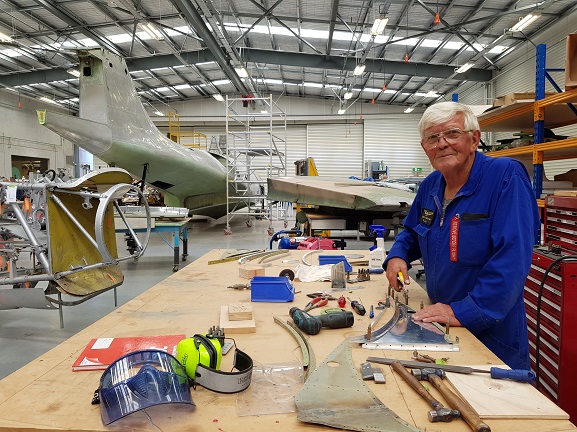
Al Woodley
Technical Volunteer
In 1986, RNZAF airframe fitter, Alan (Al) Woodley, took the opportunity for a posting to Wigram, to help get the RNZAF Museum ready for its grand opening the following year. There aren’t many people on our team today who have had such a long association with the Museum, or as much experience restoring historic aircraft as Al, and we’re lucky to still have him on board as a volunteer.
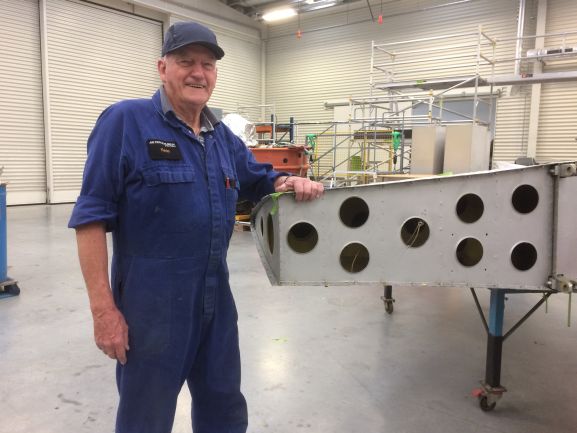
Kevin Feary
Technical Volunteer
The pay’s not great, but it’s the best job I’ve ever had!”, says technical volunteer, Kevin Feary. Brought up in Hornby, with both a passion for and the sound of aircraft all around, Kevin came to an open day at the Museum many years ago and saw the, then, unrestored Airspeed Oxford. His first thought was, “I’d love to work on that one day”, and so he did.
Al Woodley – Technical Volunteer
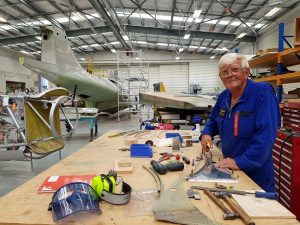
Al had an interest in aircraft from an early age; his father had been in the Air Force during the War, and took him to air shows at Taieri, near Dunedin, as a boy. He joined the RNZAF in 1968, after working as a fully-qualified carpenter and joiner in his home town of Oamaru. He spent the first 18 years of his Air Force career at Woodbourne, including a period as an instructor at No. 4 Technical Training School (4TTS). As the major repair depot for the RNZAF, there was no shortage of work, and Al’s reputation for the high calibre of his craftsmanship soon led to him being seconded to other projects.
In the early 1980s, he was part of the team that took Spitfire TE288 (now in the Aircraft Hall) down from the pole outside the Brevet Club at Christchurch airport. They took it back to Woodbourne to take moulds, and remounted the fibreglass replica, before turning their attention to the original aircraft, which had been transferred to the Museum. They spent six months restoring it ‘to museum standard’, in between all the regular work they had on at Woodbourne at the time.
In 1986 Al was due for a posting to Wellington, but wasn’t too keen on that, so when the opportunity arose instead to move to Wigram to help get the Museum up and running, he went for it. At that time, the aircraft earmarked for the new Museum were being prepared in No. 7 Hangar. Al describes it being like a ‘madhouse’ at that time, as they scrambled to get everything ready for the Museum opening on 1 April 1987, the RNZAF’s 50th anniversary.
Over the next few years, Al worked on a number of Museum-related projects, including the Auster, Bleriot and Hudson aircraft. He did at stint with the RNZAF Historic Flight in the 1990s, but also had requests from around the country for assistance with privately-owned aircraft, including those of Sir Tim Wallis and others in the warbirds community, which he worked on in his own time.
Al left the RNZAF in 1999 and did five years with Air New Zealand before taking early retirement. In 2004 he returned to the Museum, this time as a volunteer. He worked initially on the P-40 restoration project, but later lent his expertise to the Oxford and more recently, the Catalina.
Al says it’s the comradeship he enjoys most about volunteering here – ‘Having been in ‘the mob’ for 30+ years, you get used to that.’ He also sees it as a way to keep busy and ‘stay above ground’. In his spare time, he’s an active member of the Wigram Model Aircraft Club, which he helped re-establish back in 1986, and flies from the airfield here twice a week. He has been building model aircraft since he was a boy, and these days he has 14 serviceable radio-controlled aircraft in his ‘hangar’. He also spends a lot of time helping out the Club’s other members, who are all ex-RNZAF, the oldest a 96-year old former Corsair pilot. Al also devotes a lot of time to his garden. He’s proud of the fact that he has been growing his own vegetables for 60 years and is completely self-sufficient when it comes to produce.
Kevin Feary – Technical Volunteer

Kevin also gave 14 years of service to the Territorial Army, working his way up to the rank of sergeant in the Royal New Zealand Armoured Corps (NZ Scottish Regiment), dressed in black, not entirely green!
In 1989, Kevin saw an emerging opportunity and took a year off work to learn about computers at Polytech before spending several years working on accountancy software. Following this, in 2000, Kevin and his wife, Saretta, moved to Sydney for a period of seven years where he worked for software developers. Home beckoned, and Kevin and Saretta moved back to New Zealand, living in Riccarton until 2016 before moving to contented retirement in Rangiora, with some travelling thrown in for good measure. Interestingly, in the past, Kevin had also read about the Moth Doctors (a team of aircraft restorers) and had decided he’d like to do that when he retired, so he approached the Museum, being taken on as a willing volunteer in 2009.
In Kevin’s time here, he has proven himself as not only a skilled worker, but also a very willing learner – always keen to develop new skills and feed his passion for all things to do with aircraft. When asked what his favourite object in the Museum is, there was no hesitation; the Airspeed Oxford, an aircraft that he really enjoyed working on and a true testament to all involved. And, with regards to what he likes most about volunteering here, “The people! Like-minded and practical people”, says Kevin.
Apart from wood working and home renovations, Kevin still very much enjoys tinkering with computers and loves flying his flight simulator, making low passes around the virtual countryside of New Zealand. Whilst not having a favourite movie, Kevin enjoys a good animated film now and again, especially when he watches them with his grandchildren.
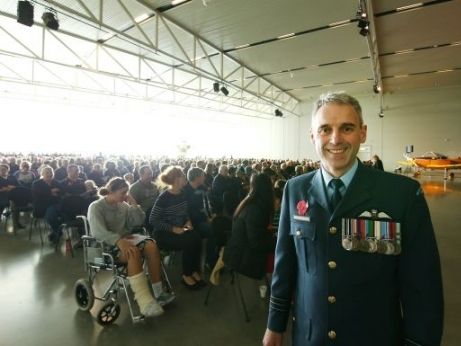
Brett Marshall
Museum Director
Wing Commander Brett Marshall’s recent appointment to the role of permanent Director of the Air Force Museum of new Zealand has heralded a new chapter in our Museum’s history. For Brett, meanwhile, returning to Wigram has brought his Air Force career full circle.

Keri Naus
Visitor Host
Keri has worked with the Air Force Museum for just over 6 years at the moment of writing. As a visitor host, her varied & fun role sees her job-sharing with Mark, doing anything from planning and running a school holiday programme, delivering talks and presentations at rest homes, hosting birthday parties and much more.
Brett Marshall – Director
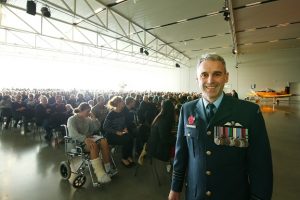
Christchurch born and bred, Brett has a close affinity with Wigram that goes back to his days as an ATC cadet with No. 18 (Avon) Squadron in the early 1980s. Having joined the Air Force in December 1986 as a direct entry pilot, he did his ‘Wings’ course at RNZAF Bases Wigram and Ohakea. He even had an additional week added to his Initial Officer Training course at Wigram, for activities associated with the opening of the Museum in April 1987!
Brett’s first posting was to 42 Squadron at Whenuapai, flying Andovers. He subsequently returned to Wigram, to fly the F27 Friendship with the Navigational and Air Electronics Telecommunications Training Squadron (NATTS), before returning to 42 Squadron in 1992. He then undertook his first operational deployment, flying Andovers in Somalia as part of the Unified Task Force, before heading to 40 Squadron to fly C-130 Hercules. He went on to a succession of operational, diplomatic and staff postings, including UN military observer roles in both the former Yuogslav Republic of Macedonia and East Timor, four years as a flying instructor, Air Advisor to the UK and Defence Attaché to Italy, and the inaugural Commanding Officer of the NZDF’s Youth Development Unit. Brett joined the Museum in 2017 as the XO, then Acting Director, helping support the team through the illness, and loss of former long-standing Director Thérèse Angelo. His appointment to the permanent, civilian role followed a rigorous two-month recruitment process. While he’ll be transitioning out of the uniform he’s worn for more than 30 years, he will remain on the Active Reserve.
Brett’s very aware that Thérèse has left an incredible legacy, and he intends to continue on that positive trajectory, while also moving forward into a new phase of development. He is keen to explore new ways of engaging with our own RNZAF personnel and the New Zealand public, bringing to life the stories of our Air Force, and those whose names are inscribed on the Roll of Honour. The other challenge on the horizon is the arrival of a P-3 Orion and C-130 Hercules, something which, to coin a phrase from his 11 year-old daughter, he is ‘nervcited’ about – excited about having these hugely significant aircraft preserved in the Museum, but also a tad nervous about the enormous task we have ahead of us to raise the funds for a suitable building to display them in.
Finally, Brett has a deep, personal connection with the memorial function of the Museum, and is keenly aware that the Roll of Honour bears the names of many friends that he has served with over the years. ‘For me, it is the heart of the Museum and why it is a privilege to work here’, he notes. ‘It comes with a responsibility to ensure that the names on our Roll of Honour are never forgotten.’
With his extensive service background and clear passion for preserving and honouring the history of the RNZAF, we have every confidence that the guardianship of our Museum is in safe hands.
Keri Naus – Visitor Host
What she enjoys most about working here is the people she meets and works with, the Museum and its collection and that she is never bored in her role!
Before starting her role at the Museum, Keri studied Psychology at Waikato University, but didn’t really love it. She moved to Wellington and changed to a double major in English Literature and Education Studies at Victoria University. She then went to Art School to do Photography and Sculpture. There were lots of part time jobs while she was studying, including working for I.H.C., teacher aide at a high school, private childcare, photography tutoring, and home help. Eventually she worked at the Govett-Brewster Art Gallery in her hometown, New Plymouth, for several years, before making her way here to Christchurch and the Air Force Museum of NZ. “For someone whose career has been mainly in the art world, and with no service history, it’s been wonderful to learn about the RNZAF, the Museum and New Zealand’s military aviation history”, she says.
Keri’s favourite object in the Museum is Fanshaw Bear. At least, her favourite small object. Her all-time favourite has to be the Bell Iroquois helicopter. Why? Well that’s a story in itself – come and find her around the Museum if it’s one you would like to hear.
In her spare time, Keri enjoys doing photography, writing, cloud watching, chancing upon a great photographic moment, reading, catch-ups with friends and family.
When asked about her favourite movie, she said “I find it hard to pick just one. The Lord of the Rings trilogy is high on the list. I lived in Wellington while they were filming and there was a buoyant sense of creativity and possibility in the city at the time. For me it’s hard to separate that feeling from the actual movies. Special mention has to go to ‘The Breakfast Club’ as well”.

Luke Damen
Volunteer Guide
When volunteer guide Luke Damen watched British bombers fly over his home city of The Hague in the Netherlands at the end of World War Two, little did he know that in one of those aircraft was a New Zealander whom he would meet many years later, at the Air Force Museum of New Zealand.

Frank Goorhuis
Marketing & Social Media Coordinator
Frank is one of the newest members of the Air Force Museum team, coming on board in March 2021 as our Marketing and Social Media Coordinator.
Luke Damen – Volunteer Guide
Life in the Netherlands after the war was very difficult, with severe housing shortages, low pay and limited prospects. Luke was called up for his compulsory military training when he was 19 and during his 18 months in the Army, began to think about his future. He spent another couple of years after he got out studying at the Royal Institute of Analytical Chemistry and working as a laboratory assistant for the Dutch Institute of Water Pollution Control in The Hague. By then, Dutch people were emigrating by the thousands. Eventually he decided to make the move himself, and went through his options, narrowing them down to Australia and New Zealand. In the end, the life-changing decision was made by flipping a coin – it landed on New Zealand.
Luke arrived in Christchurch with nothing but £30, some clothes and a few chemistry books. He knew no one, and spoke limited English, but with his specialist analytical chemistry background was soon put to work on the new wastewater treatment plant at Bromley. He set up all the laboratory procedures and did the first analyses, and went on to work his whole career there, becoming the Chief Chemist and finishing up as the Laboratory Manager for the Christchurch City Council.
After taking early retirement, Luke decided he needed to find some volunteer work to keep busy. He learned that the Air Force Museum was looking for volunteer guides, and as he’d always had a general interest in aircraft, decided to give it a go. He came in for an interview with Mr Neville Staples, then volunteer coordinator and a volunteer guide himself. During the course of the conversation, they discovered they had something in common. Neville had been a navigator with No. 75 (NZ) Squadron RAF during World War Two, and had flown over the Hague during Operation Manna. They worked out from Neville’s logbook that he would have flown over Luke, on the day that he and his brother watched from the roof.
More than 20 years later, Luke still enjoys his Wednesday guide duties and says that contact with the public is the biggest reward for volunteering. He enjoys meeting people from all over the world and seeing visitors make connections and share stories.
When he’s not volunteering at the Air Force Museum, Luke enjoys pursuing his number one hobby – astronomy. When he first came to New Zealand, he was amazed by the clarity of the night sky and was a long-time member of the Canterbury Astronomical Society since first joining in 1966.
Frank Goorhuis – Marketing & Social Media Coordinator

The dynamic nature of Frank’s role at the Museum mean that no two days are the same. He might find himself organising and promoting a kids’ event one day and writing newsletters and curating social media content the next. What all his duties have in common is that they get a message out to our (future) visitors and online followers.
What Frank enjoys most about working at the Air Force Museum of New Zealand is the variety of visitors we get to engage with, “Some are only months old, others may be in their nineties. Some just enjoy looking at the big aircraft while others know every little detail about them.” Speaking of big aircraft, he already has a favourite thing in the Museum: “I really enjoy sitting down with a coffee and getting some mahi done by the Bristol Freighter. Maybe it’s because it’s so humongous, or maybe it’s because I associate it with caffeine!”
When he’s not at work, Frank loves to bake bread, make sauces and even spirits! Not a single glass jar or bottle gets thrown out if it can be refilled. Playing the piano or going for walks around Ōtautahi are some favourite pastimes as well. His favourite film is the 2016 science-fiction romance ‘Passengers’: “There’s only three actors whose names I have to remember, and who doesn’t love space?!”




